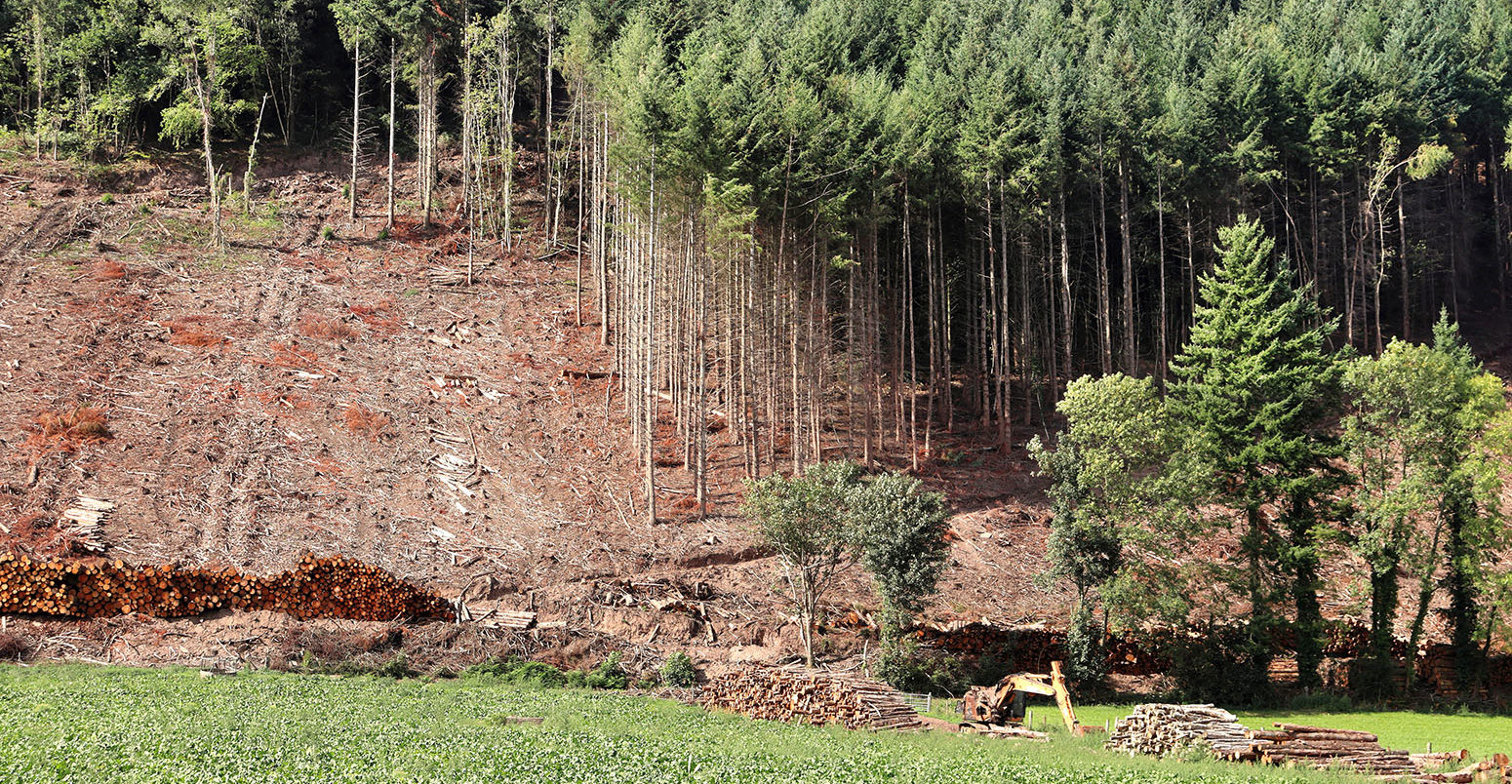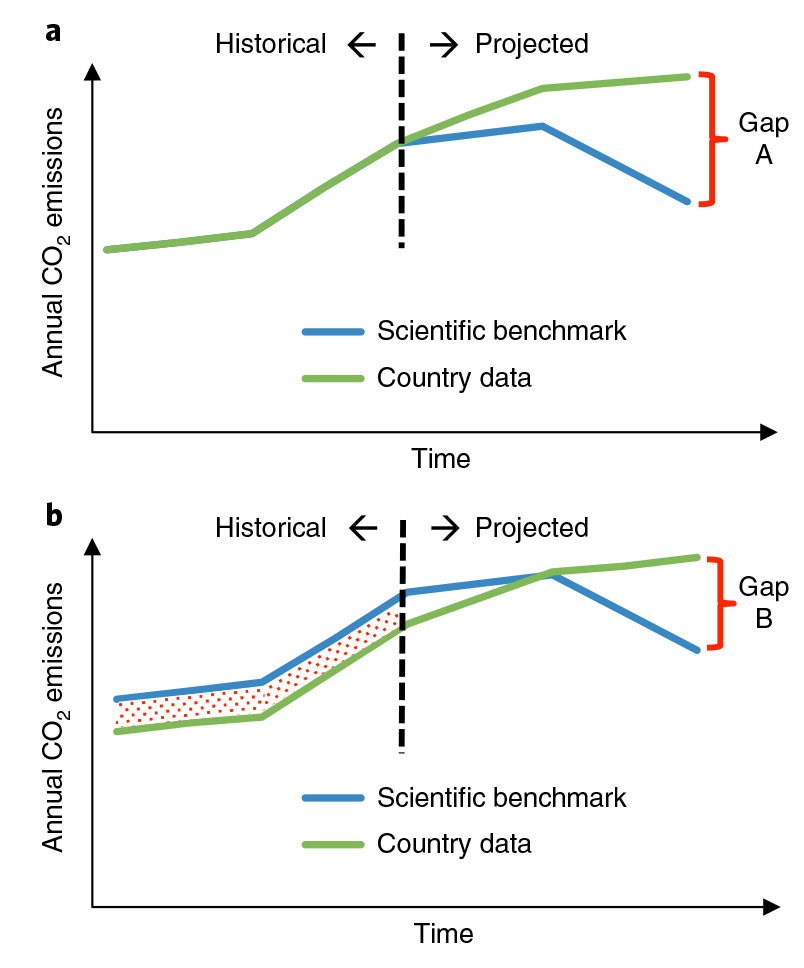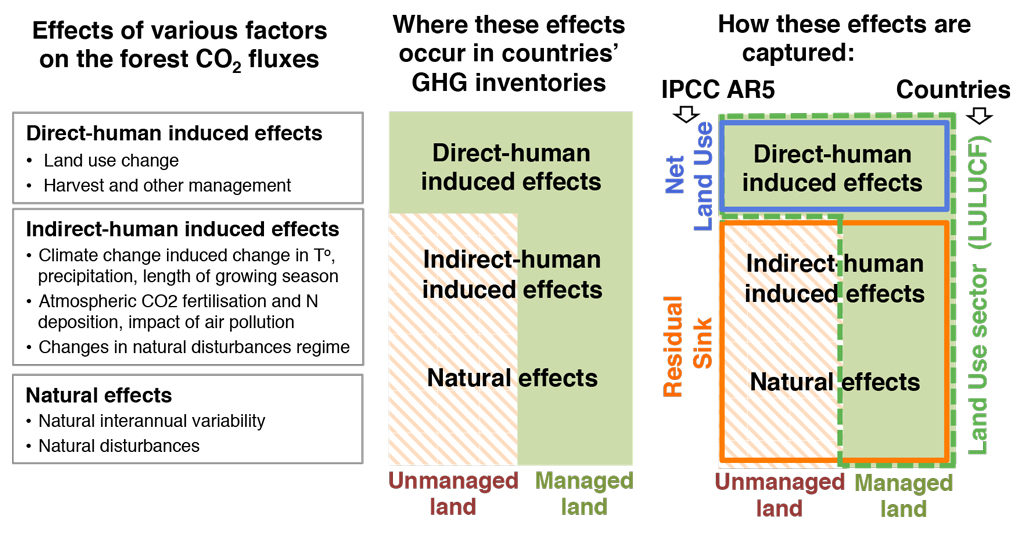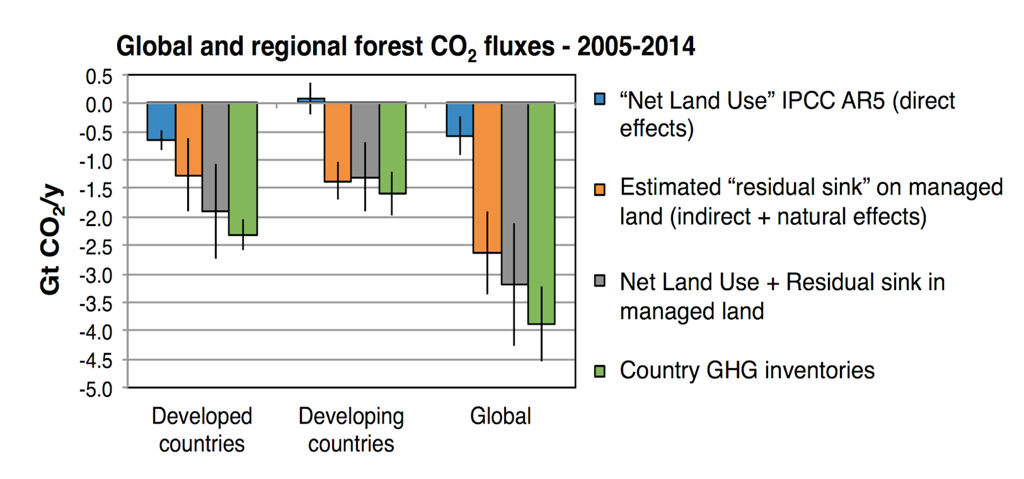
Guest post: Credible tracking of land-use emissions under the Paris Agreement

Multiple authors
09.24.18
Multiple authors
24.09.2018 | 4:00pmDr Giacomo Grassi is a scientific officer at the Joint Research Centre of the European Commission; Dr Jo House is a reader in environmental science and policy at the University of Bristol’s Cabot Institute; Dr Werner Kurz is a senior research scientist at Natural Resources Canada, Canadian Forest Service; and Dr Glen Peters is a research director at the CICERO Center for International Climate Research in Norway.
The global modelling community and national governments apply different methods to measure and report land-based greenhouse gas (GHG) emissions. Both methods can be justified, but the differences make it difficult to track progress towards the goals of the Paris Agreement.
In a new paper in Nature Climate Change, we quantify the differences in independent estimates of land-related GHG uptakes and emissions (known collectively as “fluxes”) between those reported by countries in their GHG inventories and those produced by the global modelling community. It explores the reasons for these differences and outlines ways to reconcile them.
Stocktake
The Paris Agreement calls for global warming to be limited to “well below 2C” and for GHG “neutrality” by the second half of this century. GHG neutrality requires that human-caused emissions must be balanced by GHG removals from the atmosphere.
Achieving this balance requires two things to happen simultaneously – a dramatic reduction of fossil-fuel and land-based GHG emissions and creating “net CO2 sinks” (“negative emissions” that remove CO2 from the atmosphere).
There is now a high expectation that a significant proportion of the required reduction in GHG emissions will come from changing the way we use land. This is evident in both the national pledges under Paris, where land use is assumed to provide up to a quarter of planned emission reductions by 2030, and in the model studies of pathways to achieve 2C.
This potential includes reducing emissions from deforestation, as well as enhancing the current capacity of CO2 “sinks”. Globally, terrestrial ecosystems (mainly forests) absorb nearly one third of the total CO2 emissions caused by human activities. While new technologies to remove CO2 from the atmosphere will be eventually needed, forests are, at present, the most important CO2 sink that humans can manage.
Unlike emissions from fossil fuel use and industry, emissions and sinks from land-based activities are notoriously difficult to measure and verify. In fact, a large discrepancy has already been identified between countries’ GHG inventories and independent global modelling studies.
The Paris Agreement includes a periodic “global stocktake” every five years from 2023 to assess collective progress towards the long-term temperature goal in light of the “best available science”.
To facilitate this assessment, historical human-caused emissions and future mitigation pledges (known as nationally determined contributions, or NDCs) will need to be compared with independent science benchmarks of both historical emissions and trajectories of what is necessary to meet the “well-below 2C” target.
This approach requires that country GHG inventories and independent scientific estimates are consistent and comparable (as in the upper panel of the figure below). If country estimates are not consistent with science benchmarks (as in the lower panel), then the need for further action could be under or over estimated.

The global stocktake’s assessment of the collective progress toward the long-term targets of the Paris Agreement will likely benchmark the scientific trajectories of GHG emissions reduction (from independent global models, as reflected in IPCC Assessment Reports) against the projected collective country mitigation pledged targets to identify the expected emissions gap. Panel (a) shows an ideal situation where historical emissions from GHG inventories are the same as those from independent scientific studies using global datasets and modelling approaches. This gives more confidence in assessing the gap in progress that remains to be addressed in future mitigation pledges. If a discrepancy exists for the historical period (b) the future emission gap could be estimated less accurately. Source: Grassi et al. (2018).
Conceptual gap
In our new study, we highlight a discrepancy of four gigatonnes of CO2 per year (GtCO2/y) in global land-related CO2 net emissions (for the period 2005-2014) between estimates based on countries’ GHG inventories reported to UNFCCC and independent scientific estimates from the global modelling community (as detailed by the Global Carbon Project and assessed in the Intergovernmental Panel on Climate Change’s, IPCC, fifth assessment report).
This discrepancy is equivalent to 10% of total human-caused CO2 emissions over this period.
To understand the reasons of this discrepancy, we have explored the impact of differences in estimating what part of a forest CO2 sink is “anthropogenic”, or human caused.
Due to differences in purpose and scope, the scientific modelling community supporting the IPCC assessment reports and the IPCC guidelines for national GHG inventories (used by countries for their emission reporting) have developed different approaches to identify what “anthropogenic” means in relation to GHG sources and sinks from land.
The main conceptual differences in defining the anthropogenic land CO2 flux between the IPCC AR5 and countries’ GHG inventories can be seen in the figure below. This chart shows the kind of effects influencing land CO2 fluxes (left), where these effects occur (centre), and how these effects are captured in the IPCC AR5 and in countries’ GHG inventories (right).

The main conceptual differences in defining “anthropogenic” land CO2 sources and sinks between the global model approaches assessed in IPCC AR5 and countries’ GHG inventories. Source: Grassi et al. (2018).
Sources and sinks directly resulting from land activities that change land cover (e.g. converting forests to agriculture, or vice versa) and wood harvest are known as “direct human-induced effects”. These are the only effects included as anthropogenic by the global modelling communities, and are typically referred to as the change in “Net Land Use” flux (blue box in figure).
There are, however, other drivers affecting forest fluxes including changing environmental conditions, such as CO2 fertilisation, nitrogen deposition and climate change, that are considered “indirect anthropogenic effects”. The net effect of these environmental changes globally is to increase the land sink.
The global modelling community treats this sink as part of the natural land response (i.e. as non-anthropogenic), along with fluxes due to “natural effects”, such as interannual variability and natural disturbances. It is often termed the “residual sink” due to the way it is calculated (orange box in figure).
By contrast, due to the difficulty in providing widely applicable and scientifically robust methods to isolate direct human-induced effects that all countries are able to apply, the IPCC guidelines for national GHG inventories have adopted the “managed land” concept as a proxy for measuring and estimating “anthropogenic” land GHG fluxes.
Countries identify areas of land that are “managed” (each using their own definition) and report all the GHG fluxes within those lands. As shown in the figure above (green shading in the middle panel), the fluxes captured on “managed “ lands often includes the impacts of environmental change, as well as those due to natural effects. Furthermore, the area of “managed” lands in GHG inventory estimates is, typically, larger than that experiencing direct-anthropogenic effects in the global models.
In other words, estimates of emissions of land-based activities from IPCC assessment reports and country reports are different, because they have different approaches to estimating what “anthropogenic” fluxes are.
Both approaches are valid in their own specific contexts, but they are not comparable. However, for a credible and accurate tracking of collective progress under the global stocktake, these conceptual differences need to be reconciled.
Speak the same language
In our paper, we have explored whether a different disaggregation and combination of global model results – through post-processing of existing estimates – may help reconcile the conceptual differences described above.
Our framework adds up the modelled estimates associated with direct effects (blue box in earlier figure) with those associated with indirect and natural effects on areas that could be considered “managed forest” (i.e. the right part of orange box in the earlier figure). This sum is then compared with the anthropogenic forest fluxes from GHG inventories (dashed green box in the earlier figure).
Our results shows that the large discrepancy (4 GtCO2/y globally) in land-related fluxes between GHG inventories (green column in figure below) and IPCC AR5 modelling studies (blue column) is associated mostly (80%) with differences in managed forest sink estimates.
This gap can be largely reconciled when the impact of environmental change (indirect effects) on managed lands (orange columns) is added to the direct effects (blue column) from IPCC AR5 (total grey columns). An even greater reconciliation occurs when differences in managed land area between GHG inventories and global models are taken into account.

Comparison and reconciliation of global forest net CO2 fluxes in the period 2005-2014 between global models and countries’ GHG inventories. Based on Grassi et al. (2018).
Recommendations
Our study shows a pragmatic way to reconcile the large discrepancy in the global net “anthropogenic” land CO2 flux estimates between countries GHG inventories and emissions trajectories assessed in IPCC assessment reports and provide concrete recommendations.
For example, countries could provide more transparent and complete information on what is included in their GHG inventories. The global carbon modelling community could design model experiments and outputs to enable the results to be separated out in a way that is more comparable with countries’ inventories and, thus, more policy relevant.
![]()
Our recommendations also apply to the modelling of future emission pathways from integrated assessment models, which are used to assess the collective gap between current country mitigation ambition and a “well-below 2C” pathway.
If our recommendations for disaggregation were reflected in the forthcoming IPCC reports (such as the special report on climate change and land, and AR6), it would deepen the understanding of model-inventory differences and facilitate a more robust global stocktake.
Without speaking the same language, progress towards achieving the “balance” between anthropogenic emissions and removals in the second half of this century, needed to reach the ambitious “well-below 2C” target of the Paris Agreement, cannot be accurately assessed.
Grassi, G., et al. (2018) Reconciling global model estimates and country reporting of anthropogenic forest CO2 sinks, Nature Climate Change, doi:10.1038/s41558-018-0283-x
-
Guest post: Credible tracking of land-use emissions under the Paris Agreement
-
Guest post: Fixing the discrepancy in how forest CO2 is measured

